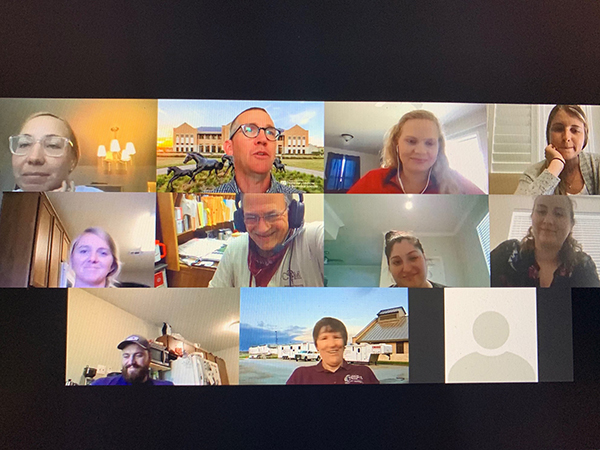Texas A&M VET Prepares Veterinary Students For Entering Jobs In Midst Of Pandemic
Story by Aubrey Bloom, CVMBS Communications
When the Texas A&M Veterinary Emergency Team (VET) is called into action, it’s normally the animals they’re concerned about, but COVID-19 has presented a different challenge—how to continue operations when it’s people who are at risk.

“Usually, if we talk about a disaster like a fire or a hurricane, we talk about continuing operations in the face of displaced or injured animals,” said VET member Dr. Frank Cerfogli. “Usually, our emergency is a population of found pets whose residence or ownership are a mystery in that we don’t know who the owners are. Now, our pets’ ownership is no mystery; the compounding factor is the social distancing.”
While team members are adapting to a more human-centered approach, Cerfogli and Dr. Norberto Espitia—who is the VET’s operations, planning, and safety officer—are also using the experience to both serve the veterinary profession and educate the fourth-year veterinary students (4VMs) participating in the VET’s “Community Connections” clinical rotation.
Where the VET typically works with counties and local officials on disaster planning, the team is currently utilizing distance education technology and video conferencing to meet with private practices around Texas so students can learn how to develop plans for safely remaining open during a pandemic situation.
The 4VMs assist by creating plans for their future practices. Some are hypothetical, but since the majority of 4VMs already have jobs lined up, many of them are specific to their future practices.
“They’re researching their county’s recommendations for essential places of business, for COVID-19, and for staying open, as well as researching entities such as the Chamber of Commerce for their city,” Cerfogli said. “We’re hopefully giving them all of the knowledge for COVID-19 response before they actually step into the practice in the next few weeks or months.”
Emily Adamson, one of the 4VMs who recently completed the rotation, said she had been looking forward to the VET’s clinical rotation and was initially worried that the distance education aspect resulting from classes moving online would lessen the impact.
“In a way, though, it actually strengthened the concepts we learned regarding emergency preparedness and response,” she said. “It’s added a layer of urgency and relevance to the thought that we, as veterinarians, need to have a plan with our future places of employment to ensure that even in times of disaster or hardship, we can still provide high-quality care to our patients.”
One of the big benefits of this rotation is that, for the most part, they aren’t working with hypotheticals. The pandemic will be ongoing when these students join the workforce in a few short weeks, and now they feel better equipped to handle it.
“I’m more familiar with my county’s structure and plan for situations like this,” Adamson said. “Understanding how I can better utilize resources available to businesses during times of hardship makes me feel more confident that I can enter the veterinary workforce and still provide quality veterinary care, even during this pandemic.”
At the end of each week, students in the Community Connections rotation hold video conferences with practitioners around the state to discuss how they’re adapting their processes and how they could implement the plans that the students have come up with.
“Prior to meeting with the practitioners, the students are given vital information about the local area, including the primary hazards and risk assessment, population demographics, animal census, cultural diversity, and county topography,” Espitia said. “The students are also required to research the county government’s organizational structure and to be able to describe the lines of communication within the jurisdiction that are to be adopted in the event of a local disaster.”
Right now, the veterinary playbook for COVID-19 response is fairly straightforward. Practices are moving to curbside drop-off and pick-up, and many are moving to only seeing urgent and emergent cases.
But this means that cases such as spays and neuters or routine procedures such as nail trims— which are not essential procedures and would require the use of personal protective equipment that everyone is currently trying to conserve—cannot be seen during the pandemic.
This creates a challenge for veterinarians and the 4VMs, alike—how do they prioritize those kinds of cases or procedures once practices start to normalize operations.
Cerfogli said that nationally, the number of those types of procedures could be in the millions each week, and now most veterinarians are performing close to zero. So, practices and animal shelters have to consider how they’re going to scale back up those operations.
Ultimately, just as the veterinary profession is being forced to adapt and overcome, the VET faculty—and all faculty at the College of Veterinary Medicine & Biomedical Sciences (CVM)—are working to make the 4VM coursework as relevant and applicable as possible, even when they can only teach from behind a computer screen.
“The clinicians on all of my online rotations, as well as the CVM administration team, have done a really great job working to make our experience just as valuable in the online format as it would be in-person in the clinic,” Adamson said.
###
For more information about the Texas A&M College of Veterinary Medicine & Biomedical Sciences, please visit our website at vetmed.tamu.edu or join us on Facebook, Instagram, and Twitter.
Contact Information: Jennifer Gauntt, Director of CVM Communications, Texas A&M College of Veterinary Medicine & Biomedical Sciences; jgauntt@cvm.tamu.edu; 979-862-4216


